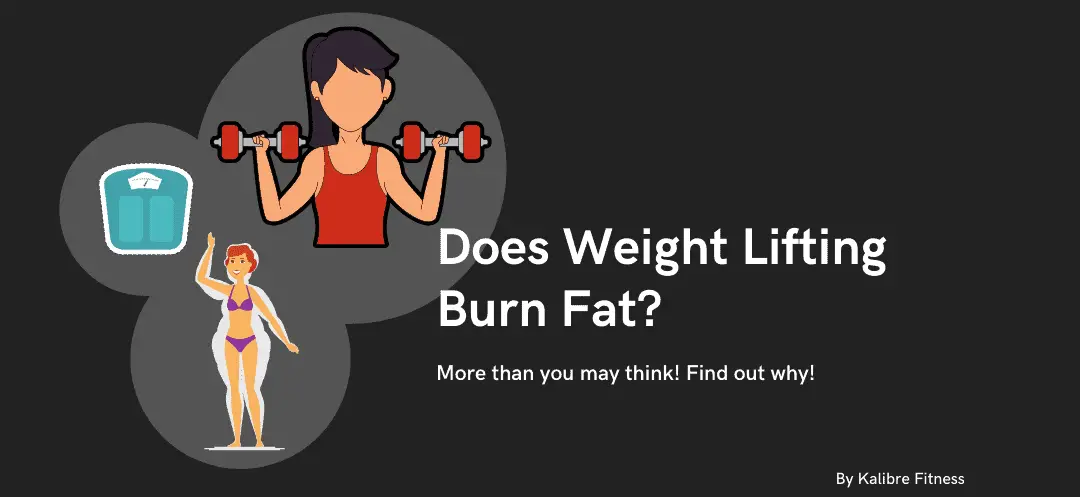Are you looking for the best way to burn fat? Are the countless hours on the cardio machine not producing any results? Has weight lifting come across your mind, but you are still not 100% convinced? If you answered yes to these questions, then this post is for you! Today I will be answering the question “does weightlifting burn fat”.
For 12 years, I have been exercising to build and maintain my ideal physique. I have dabbled in both weight training AND cardio to achieve my goals. And although I feel cardio has its place in a fat loss programme, you definitely should not underestimate the fat-burning potential of weight lifting!
Today I will be answering the “does weightlifting burn fat”. To do this, I will:
- Introduce you to 3 people who used weight training to lose fat.
- Compare the fat-burning benefits of weight training vs cardio.
- Explain how weightlifting burns fat.
- Explain why lifting weights burns fat effectively.
- Give you an idea of the results you can expect from weight training.
- Explain how to lift weights to burn fat.
Are you ready to learn everything about weightlifting to burn fat?
Let’s go!
Does Weight Lifting Burn Fat?
First and foremost, let’s answer the million-dollar question at heart.
“Does weight lifting burn fat?”
The short answer is yes! In fact, weightlifting is incredibly efficient at burning fat.
Let’s look at two case studies which illustrate the fat-burning power of weight lifting.
Case Study #1 Tiago From Physiqonomics
In this case study, Tiago enlisted the help of Aadam from Physiqonomics to burn body fat through weight lifting.
Tiago was put on a 20-week weight training plan (combined with a diet plan). The workout plan was relatively simple, focusing on 3 weight lifting exercises:
- Bench Press.
- Squat.
- Deadlift.
And the results were simply astounding.

Tiago lost almost 25 pounds in 20 weeks! Not only did he lose fat, but he also became much leaner!
Amazingly, Tiago’s journey did not involve any of the unhealthy practices commonly associated with weight loss (such as crash dieting, unnecessary food restrictions, and affecting overall life quality).
Case Study #2 Mindy From The Hill Kansas City
In another case study, Coach Mindy From The Hill Kansas City demonstrated to herself how a resistance training (weight lifting) programme can produce fat loss results. Mindy also combined weight training with a diet plan.
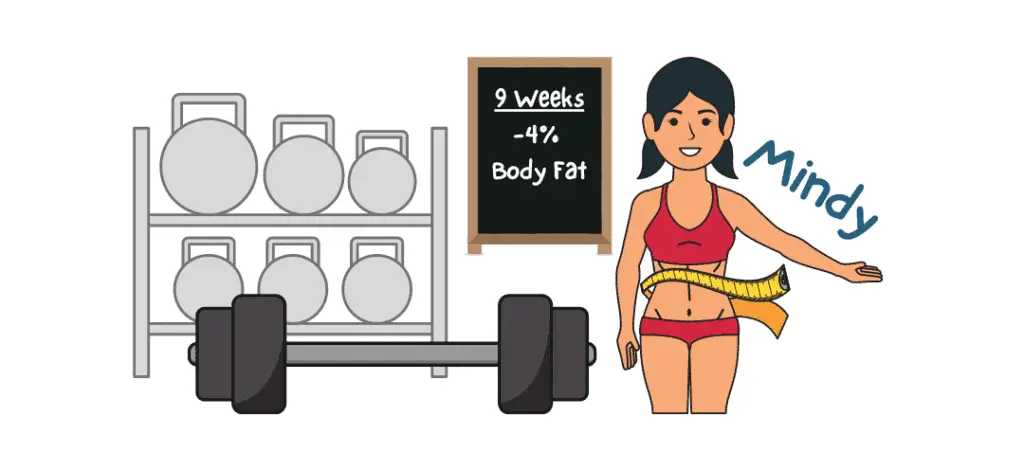
Mindy’s results were equally impressive, losing 4% body fat in 9 weeks!
Similarly to Tiago, Mindy also achieved a more toned and athletic-looking physique
So if you ever find yourself asking “does weight lifting burn fat?”, remember Tiago and Mindy!
Does Weight Lifting Burn Fat Better Than Cardio?
Now for the second million-dollar question (and answer!):
“Does weight lifting burn fat BETTER than cardio?”
Weight training certainly has the right to lay claim as a powerful fat burner, but is it the BEST fat burner?
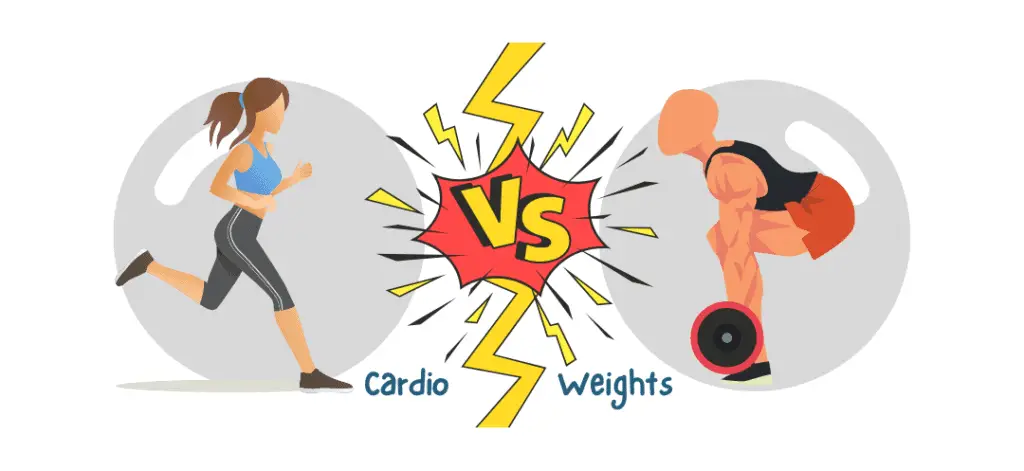
This is a common question. It’s also a very good question because cardio has traditionally been associated with efficient fat loss.
So wouldn’t you like to know which training method- weights or cardio- reigns supreme for fat loss?
Steady State Cardio Burns More Calories DURING Exercise….
On face value, steady-state cardio seems to burn more fat than weight lifting.
Indeed, this is supported by the Harvard Medical School Calorie Expenditure Database. The publication reveals the calorie expenditure of a 125lb person doing various exercises. And the database shows that:
- Moderate running at 5mph will burn 240 calories in 30 minutes.
- Vigorous weight lifting will burn 180 calories in 30 minutes.
Therefore this indicates that steady-state cardio burns more fat than weight lifting.
However…..
Weight Lifting Burns More TOTAL Calories
Weight lifting burns more fat over a longer duration of time than cardio. So what’s the deal?
How can weight lifting burn less calories during exercise, but more calories in overall?
Gillian D’Souza from Medical News Today explains this paradox very elegantly.
Gillian notes that, although cardio burns more calories during exercise, weight lifting CONTINUEs to burn calories even after the workout has finished.
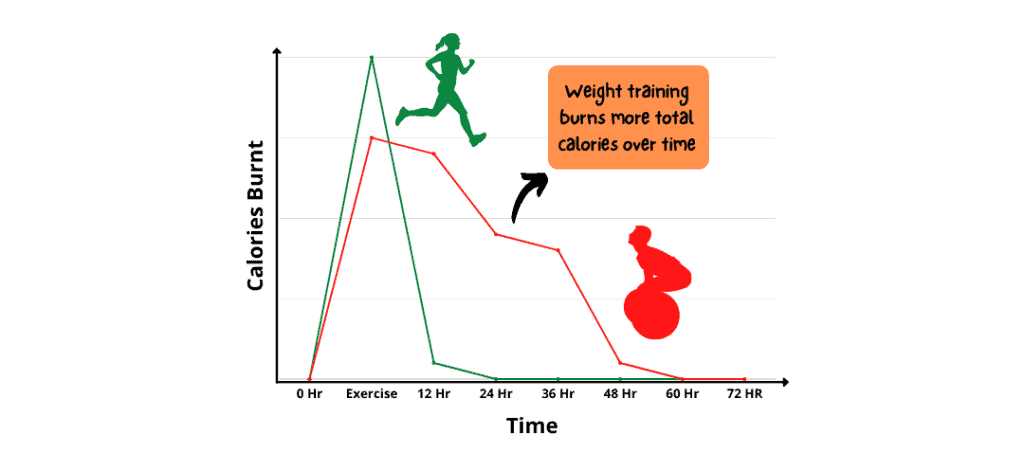
This phenomenon has been attributed to a process called Excess Post-exercise Oxygen Consumption (EPOC).
EPOC is more commonly known as the “Afterburn Effect”, and has been shown to increase metabolism for up to 48 hours post-exercise!
Think of Afterburn as “passive fat-burning”. Put in the work at the start, and reap steady rewards after!
Best Of Both Worlds?
Therefore weight lifting not only burns fat, but it can burn MORE fat than cardio. That being said, as with most things in life, the best option is to diversify.
As Max Posternak from Gravity Transformation explains (featured video), this means combining weight training with cardio training to gain MAXIMAL fat-burning results. Typically, this would involve performing a cardio session after a weight-lifting workout.
In fact, a combined approach has been shown to decrease body fat and waist circumference more effectively than weights or cardio individually.
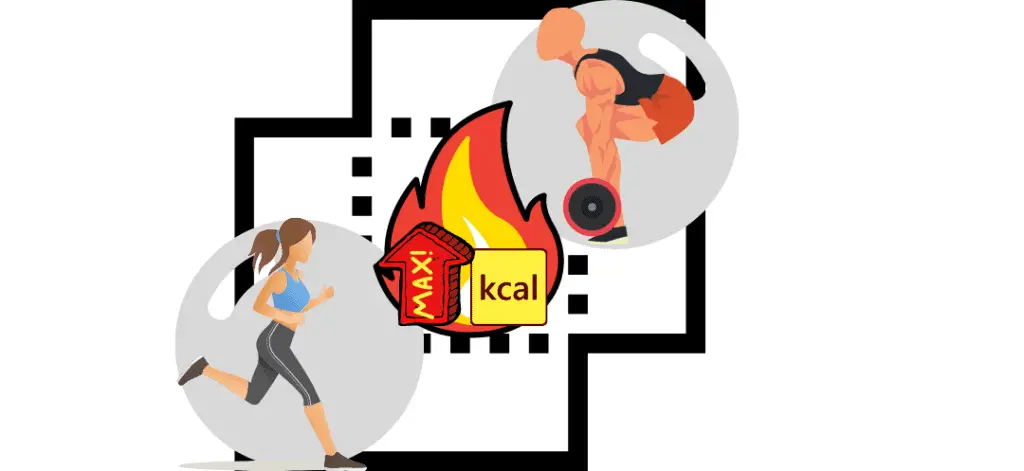
Now you may be thinking
“I can’t afford to spend hours at the gym every week!”
Fear not!
Max recommends a form of weight training called Peripheral Heart Action (PHA) training to gain the best of both worlds.
PHA training is a form of high-intensity resistance training. And it involves performing consecutive sets (each working different muscle groups), without a break. This is more commonly known as “super sets”.
Combine Weights With Cardio To Burn The MOST Fat!
The take-home message? Don’t focus your efforts solely on weights vs cardio. Instead, combine both to maximise fat burning!
Remember this the next time you find yourself wondering “does lifting weights burn fat?”. And before you go on your next 1-hour treadmill slog, really consider weight lifting as an alternative!
Awesome.
Now that I have covered that question, we can dive deeper.
HOW does weightlifting actually burn fat?
What happens inside your body during weight lifting that makes it a better fat burner than cardio?
After all, if you are to move forward in your journey to burn fat by weight lifting, you will probably like to know how weight lifting changes your body right?
Let’s dive right in…
The Role Of Muscle In Burning Fat
Before we answer the question “how does weight lifting burn fat”, I will first address two basic fundamentals.
What is fat? And what is muscle?
If you understand how fat and muscle function in the body, you will understand how weight lifting burns fat.
So let’s begin with the demon subject of this post. What is fat?
What Is Body Fat?
You may be surprised to hear this, but everyone has body fat all over their body. Even the leanest, most shredded gym bro with the dream beach body has body fat.
But have you ever wondered what body fat actually is?
Why do those lumps and bumps form around your waistline?
Fat, or fatty tissue, is composed of adipocytes. These are fat cells which serve as microscopic energy storage facilities. Like a storage warehouse for batteries, if you like.
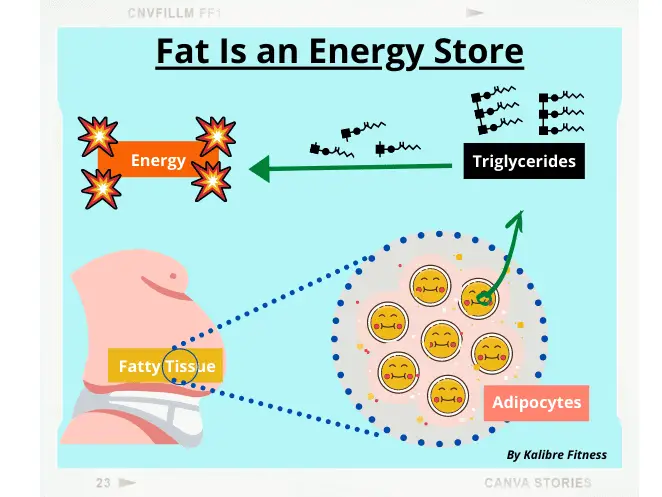
The purpose of these “storage facilities” is to stockpile triglycerides (fat molecules).
The body does this because triglycerides are energy-rich. In other words, triglycerides contain a lot of calories.
By stockpiling calories in the form of fatty tissue, your body is cleverly building up an energy reserve for future emergencies (such as when food runs out).
The problem is that some of us stockpile TOO MUCH fat. And we want to get rid of it.
That’s where our friend Mr Muscle comes in…..
What Is Muscle?
Muscle is another type of body tissue. But it has a very unique property. It can contract. And muscle contractions allow you to lift heavy weights.
So features allow a muscle to contract?
To understand how a muscle contraction occurs, you must first know the structure of the muscle.
The structure of every skeletal muscle is very similar to that of a large steel cable.
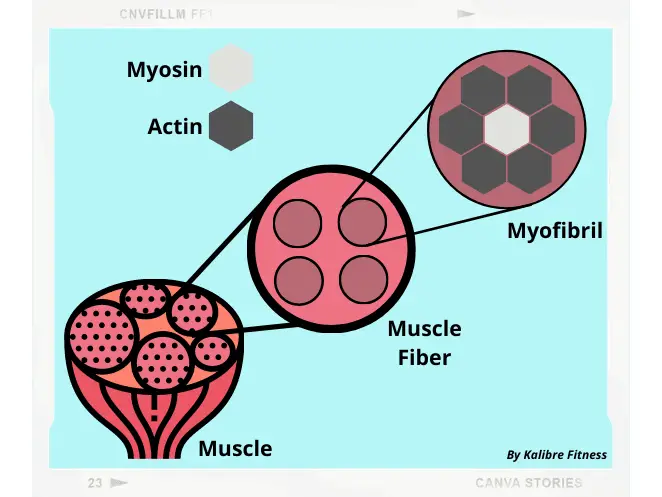
Every muscle contains hundreds to thousands of smaller muscle fibres. Each muscle fiber consists of even smaller myofibrils. And each myofibril consists of even smaller actin and myosin microfilaments.(1)
Thus, many muscle fibres come together to form a muscle. Just like many cable filaments come together to form a steel cable.
A muscle contracts when these muscle fibres pull on each other, bringing the fibres closer together and causing the muscle to become shorter.
Weight Lifting Burns Calories!
Just like with anything that physically moves, a muscle contraction requires energy to fuel the movement. And this energy comes from burning calories. This is important to remember when asking “does weightlifting burn fat”.
The calories to fuel muscle contraction come from 2 primary sources. These 2 energy sources are:
- Blood nutrients.
- Muscular glycogen.
1. Blood Nutrients
Under everyday circumstances, your muscles receive energy from nutrients delivered by the blood. These nutrients are in turn supplied by the foods you consume.
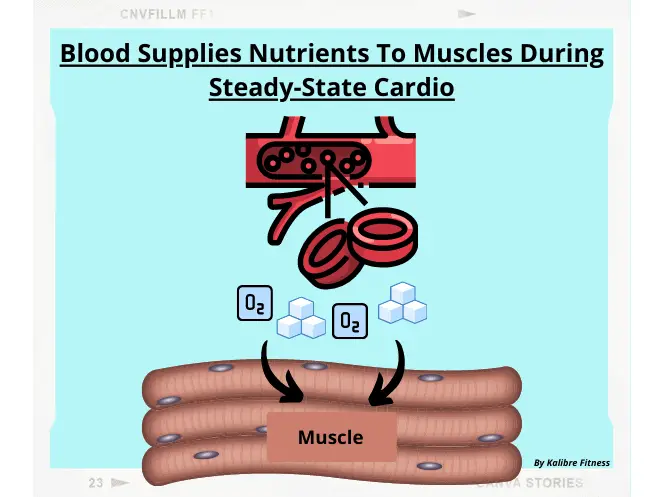
In the case of aerobic exercises (such as steady-state cardio), blood nutrients are also sufficient to fuel the muscle.
Therefore your muscles receive a steady supply of blood nutrients as it continues to contract repeatedly during steady-state cardio.
2. Muscular Glycogen
Each of your skeletal muscles contains an energy reserve called glycogen. And glycogen is basically a bunch of glucose molecules packaged onto one large molecule.
Remember how fatty tissue stores energy in the form of triglycerides? Well, muscle tissue stores energy in the form of muscular glycogen.
Glycogen and triglycerides are both energy-storing molecules. The difference is that energy from glycogen is more readily accessible than triglycerides.
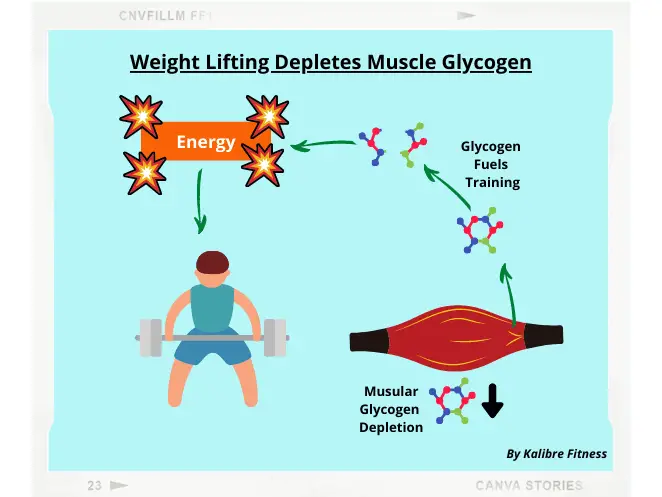
Intense weight lifting is known as an anaerobic exercise. This is a particularly intense form of exercise. In fact these exercises require so much energy, that the muscle cannot simply rely on the blood nutrients anymore.
During anaerobic exercise, your muscle is screaming for energy!
Rather than rely on energy delivery by the blood (which is slow), the muscle taps into its glycogen energy stores(2). In other words, the muscular glycogen stores are “depleted”.
“Glycogen depletion” through anaerobic exercise is an important concept when understanding “how weight lifting burns fat” (I will explain later!)
Muscular Hypertrophy Consumes Calories!
Not only does intense weight lifting deplete glycogen, it also causes the muscle to become larger. This is called muscular hypertrophy, and hypertrophy also contributes to fat burning.
First, how does weightlifting cause muscular hypertrophy?
Michael Karns (MD) from University Hospitals Sports And Medicine Institute explains how intense weight lifting causes small “micro-tears” to form in the muscle fibres.
Michael notes that micro-tear formation triggers a repair response from the body. If something is broken, it needs to be repaired right?
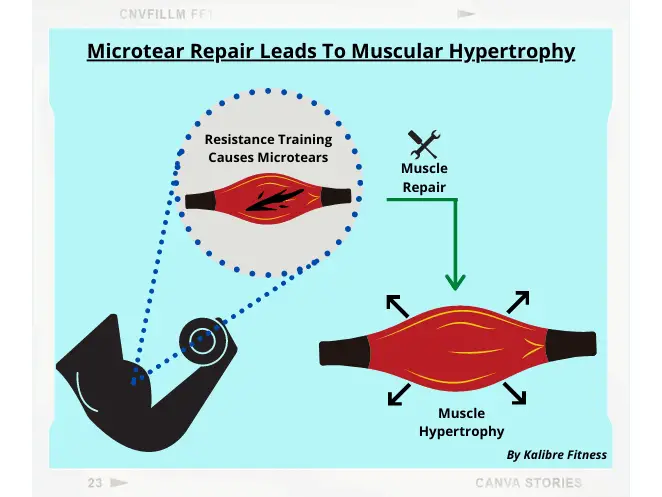
The repair response increases blood flow to the muscle. And this increases nutrient delivery to the damaged muscle to facilitate muscle repair.
Regular and intense weight lifting causes micro-tears to continually form and repair. And when you repeat this cycle over and again, the muscle adapts.
Your body is smart! It prepares itself for the next dumbbell you hurl at it!
As the muscle adapts to weight training, the muscle fibres also increase in size and number. This builds lean muscle mass, and the process consumes energy.
Therefore, regular weight lifting induces muscular hypertrophy. And hypertrophy consumes calories! This is another important concept when understanding “how does weight lifting burn fat” (again, I will expand on this later!)
Summary: Fat Stores Energy And Muscle Uses Energy
Now you know that fat stores energy in the body, and muscle consumes energy in the body (via glycogen depletion and muscular hypertrophy).
Remember these 2 concepts, because they will allow me to explain the answer to the next question.
“HOW does weight lifting burn fat?”.
How Does Weight Lifting Burn Fat?
I will now explain how weight lifting burns fat.
You have taken time to learn the basics of fat and muscle so now you deserve to know how muscle burns fat!
Here are 5 ways weight lifting burns fat.
1. Weight Lifting Burns Fat During The Workout.
As you know, muscle contractions require energy. And anaerobic exercises such as weight lifting consumes a lot of calories. But how does calorie expenditure relate to fat loss? And why does weightlifting burn fat so well?
I will give you the short answer first:
Increasing your daily calorie expenditure by lifting weights will increase the likelihood that your body will burn its fat for energy.
To ensure your body burns fat for energy, you need to make sure you are in a calorie deficit. In other words, make sure you are consuming fewer calories than you are burning (more on that later).
How Many Calories Does Weight lifting Burn?
The exact number of calories burnt during weight lifting will vary between individuals. As I mentioned before, a 125lb person can burn around 180 calories in 30 minutes.
But as Amy Golby from MyProtein notes, an intense half-hour session can burn anywhere between 100-300 calories depending on factors such as individual gender, height, weight, and current muscle mass.
Calorie Expenditure Is Proportional To Training Intensity!
One very important point to note is that energy expenditure is proportional to training intensity. In other words, the higher the intensity, the more calories you will burn.
So if your goal is to burn fat, push yourself within your own personal limits. A short but high-intensity weight-lifting workout is better than a long low-intensity workout.
Use the workout to work out, not for Instagram!
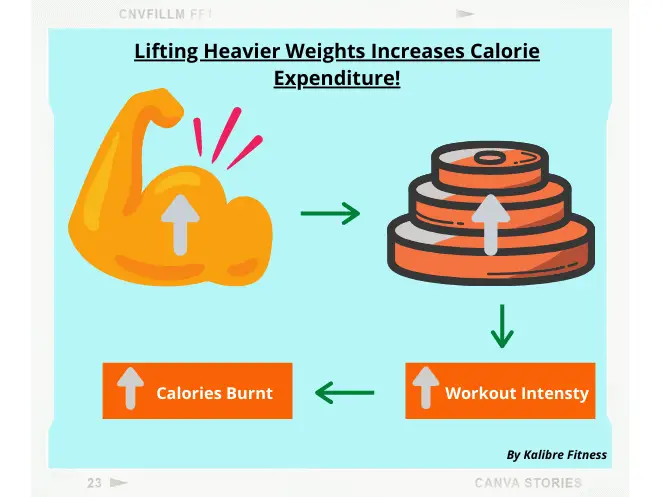
You will find that as you progress, you will naturally be able to lift heavier weights. And lifting heavier weights will burn more fat!
Check out Amy’s guide for some juicy information on the exact number of calories you can expect to burn from weightlifting!
2. Afterburn Burns Fat After The Workout (Short-Term)
Earlier, I mentioned that anaerobic weightlifting drives the Afterburn Effect (or EPOC). And EPOC increases metabolism for up to 48 hours after exercise. This in turn, increases your calorie expenditure. Therefore fat is burned for up to 48 hours after you finish working out.
Interestingly, a 2003 study and 2006 study have shown that weight lifting generates a greater Afterburn Effect, compared to steady-state cardio (such as light running cycling).
Why does weightlifting generate a larger afterburn than cardio? And how does weightlifting burn in the fat short term?
Weight Lifting Promotes The Afterburn Effect
Pete McCall from Ace Fitness explains how the anaerobic nature of a weight-lifting workout leads to a greater Afterburn Effect.
Weight Lifting Drives Afterburn By:
i) Increasing Nutrient Debt In Muscles.
ii) Increasing Muscle Repair Response.
i) Weight Lifting Increases Nutrient Debt In Muscles
As you now know, anaerobic exercises (such as weight lifting) are an extremely intense form of exercise. They require your muscles to consume vast quantities of energy in a short period of time. In contrast, energy is consumed at a slow and steady pace during steady-state cardio
As a result, anaerobic activity depletes muscular nutrients, particularly oxygen and glycogen. And this causes a “nutrient debt” to build up in the muscle.
What happens when a nutrient debt is formed?
It needs to be repaid!
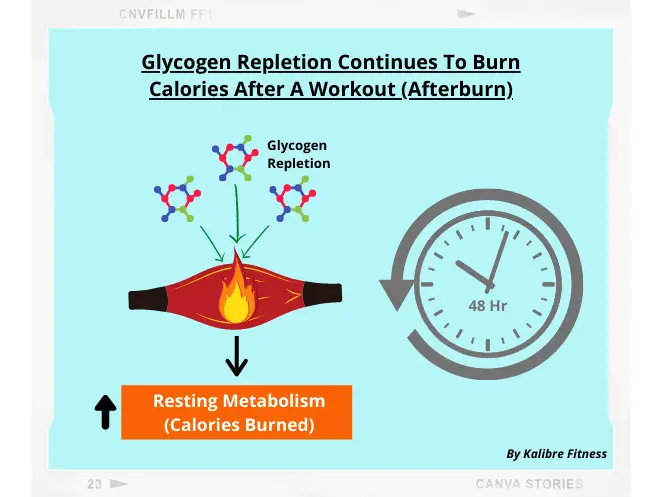
The body does this by synthesising more glycogen through a process called “glycogenesis”. And glycogenesis requires calories.
Therefore as the body begins to repay the nutrient debt (via glycogenesis), it will consume energy in the process. And this increases your metabolism for up to 48 hours after a weight-lifting workout.
ii) Weight Lifting Increases The Muscle Repair Response
As you know, weight lifting causes micro-tears to form in your muscles. And the subsequent repair process requires energy.
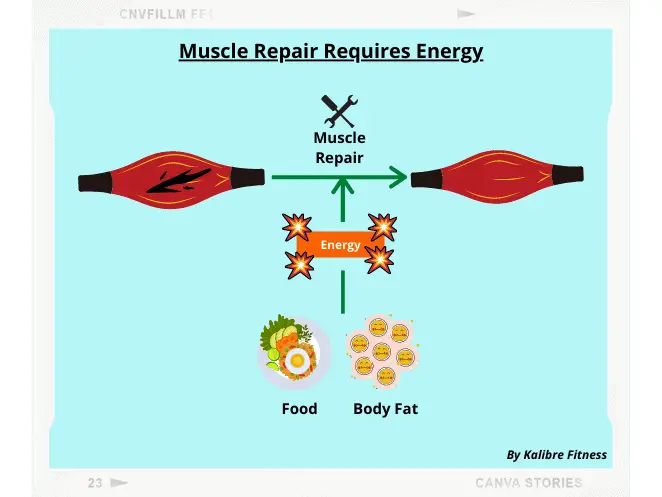
When you perform intense weight lifting regularly, you are causing more micro-tears to form in the muscle. And this stimulates the repair process.
Therefore as the body begins rebuilding damaged muscle after a weight-lifting workout, it will consume more calories to fuel the repair process. And this is the second way your metabolism will increase for up to 48 hours post-workout.
Afterburn Will Burn Fat 48 Hours After A Weight Lifting Workout!
Therefore, intense weight lifting creates a 48-hour window of “passive-fat burning” which sees your metabolism increase. In other words, your body becomes a fat-burning furnace for 48 hours after a weight-lifting workout!
Much like how repairing a damaged house requires bricks and labour, repairing muscle also requires bricks (protein) and labour (energy). If you can maintain a caloric deficit, then the body will burn fat for energy!
This makes weight lifting a great way to ensure that the calories in your next bagel are quickly burnt rather than going towards your belly fat!
If you want to find out more about Afterburn, be sure to check out Pete McCall’s article!
3. Muscular Hypertrophy Burns Fat (Long-Term)
Earlier, I mentioned that intense weightlifting leads to muscular hypertrophy. In other words, your muscles become larger. Did you know that larger muscles will also increase your long-term metabolism?
Yes, weight lifting can increase your metabolism LONGER than the mere 48-hour period associated with the Afterburn Effect!
Indeed, a 2019 study has indicated that lifting weights two or more times a week over 6 months can help those struggling with body fat management.
In this study, 92 participants were split into 3 groups:
- Group 1 lifted weights once per week.
- Group 2 lifted weights twice per week.
- Group 3 lifted weights three times a week.
The body fat of all individuals was then recorded after 6 months. What did the scientists find?
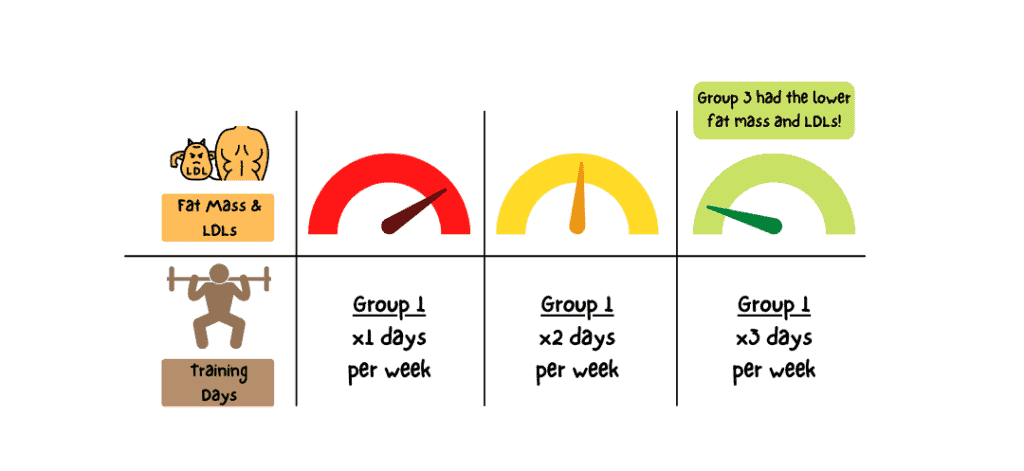
The individuals who lifted weights 3 times a week had significantly lower fat mass and LDL-cholesterol (“bad” cholesterol)!
Amazing isn’t it? Dedicating just 3 days a week to weight lifting can decrease your body fat.
So how does weightlifting burn fat in the long term?
Muscle Is Metabolically Active Tissue!
One interesting property of muscle (aside from the fact it can contract), is that it is metabolically active. This means that muscle tissue will continue to burn energy 24/7. Even at rest!
How many calories does muscle burn?
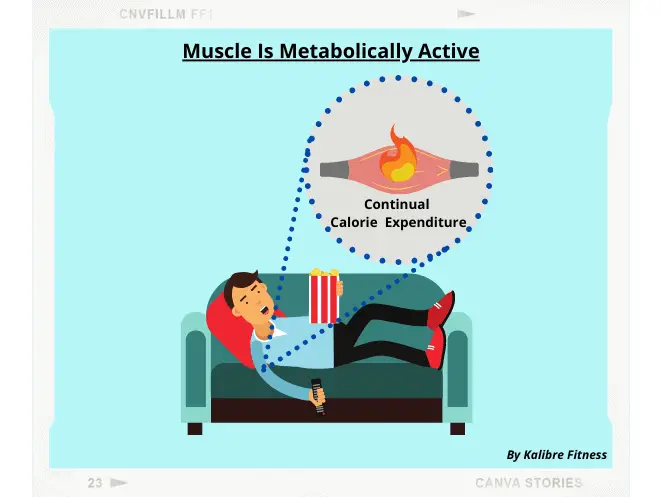
Paige Waehner from Verywellfit notes that, although the exact figure is still unclear, it is clear that weight lifting does change your metabolism. Indeed, a study has suggested that a pound of lean muscle will consume ~6 calories every day.
This may not seem like much, but consider the fact that the average body can have anywhere between 60-90% muscle mass (depending on age, gender, and training). That means a 150 pound person COULD burn up to ~800 calories every day doing absolutely nothing!
Muscle Increases Your Basal Metabolic Rate (BMR)
Therefore increasing lean muscle mass will increase your metabolism. And this will help you keep the fat at bay.
Have you ever wondered why muscular people can eat what they like, as much as they like? How are they still able to maintain their physique?
Now you know! Their larger muscles increases the amount of calories they burn every day! To put it simply, they have a higher resting metabolic rate. And this helps them to stay lean.
Every little counts when it comes to burning fat, and gaining a bit of lean muscle mass may tip the balance more favourably towards you!
4. Weight Lifting Increases Your TDEE
If you have ever looked into dieting for fat loss, you may have come across the term TDEE. It stands for Total Daily Energy Expenditure, and it simply refers to the total number of calories you burn every day.
Your BMR accounts for 60-75% of your TDEE. And since weight lifting increases your BMR (via calories burnt during a workout, the Afterburn Effect, and muscular hypertrophy), weight lifting will also increase your TDEE!
So how does a higher TDEE help you to burn fat?
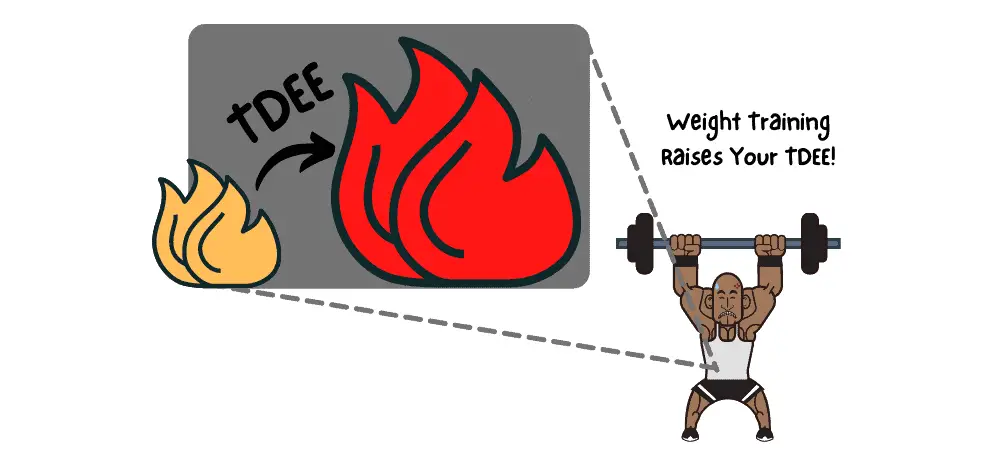
A Higher TDEE Will Burn More Fat!
Nathan Kallymer from Healthy Eater explains that a higher TDEE will facilitate a caloric deficit. A caloric deficit simply means you are consuming fewer calories than you expend.
During a caloric deficit, your diet does not provide sufficient energy to fuel your body. So what does it do instead?
It burns fat for energy!
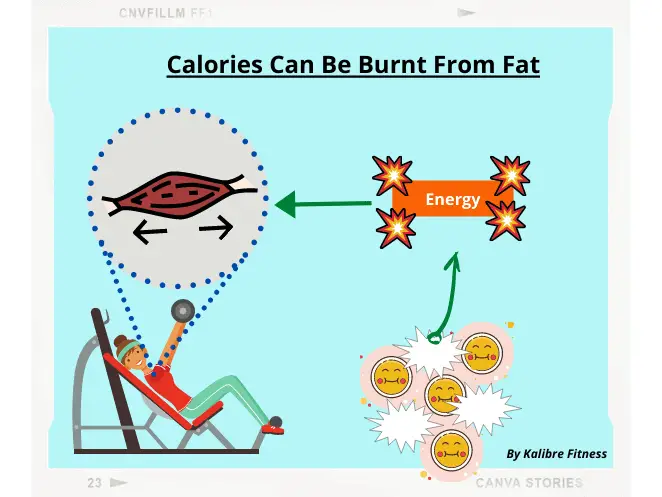
Generally speaking, the higher the TDEE, the more likely you will be in a caloric deficit. Thus, the more likely your body will burn fat for energy
If you would like to calculate your TDEE, you can check out Nathan’s article!
Alternatively, read my “Guide To Creating A Calorie Deficit Diet” to learn about the role of calorie deficits in fat loss.
5. Weight Lifting Promotes Fat-Burning Hormones.
Most people understand the importance of hormonal balance for a good mood. But did you know that hormone regulation also plays a vital role in fat loss as well?
As Olivia Hartland-Robbins from Healthista explains, weight training is an excellent way to regulate the release of hormones associated with fat gain/loss. In other words, weight training will stimulate the release of hormones that burn fat and inhibit the hormones that store fat.
These hormones include:
- Testosterone
- Human Growth Hormone
- Cortisol
What exactly do these hormones do? And why is it important to regulate the release of these hormones?
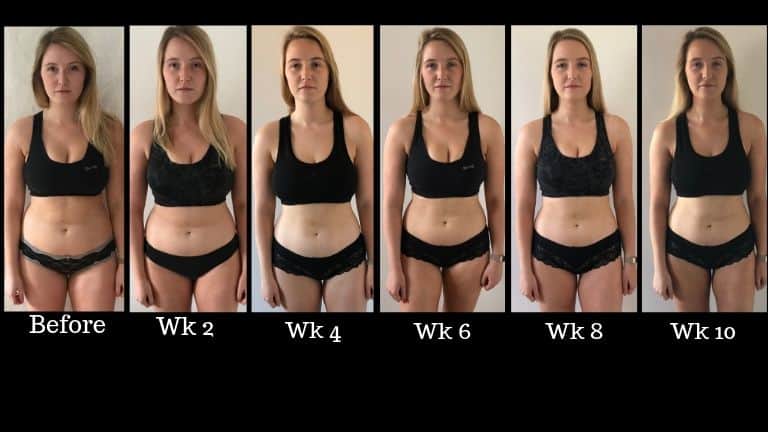
Testosterone Builds Muscle (Yes Please!)
Testosterone is traditionally known as the male sex hormone. But it is also produced naturally in females (albeit in lower quantities). Testosterone has a role in lean muscle mass repair and development.

By stimulating testosterone release, you can increase your metabolism via increased muscle repair and development. This will help you to burn more fat.
Weight lifting is a great way to stimulate testosterone release. In fact, Olivia’s PT recommends that the best exercises to stimulate testosterone release are big compound weight-lifting exercises.
Human Growth Hormone Builds Muscle And Burns Fat! (Yes Please!)
Human growth hormone is another hormone involved in muscle repair and maintenance. Again, it is also found naturally in both males and females. Like testosterone, growth hormone is also released after weight lifting.
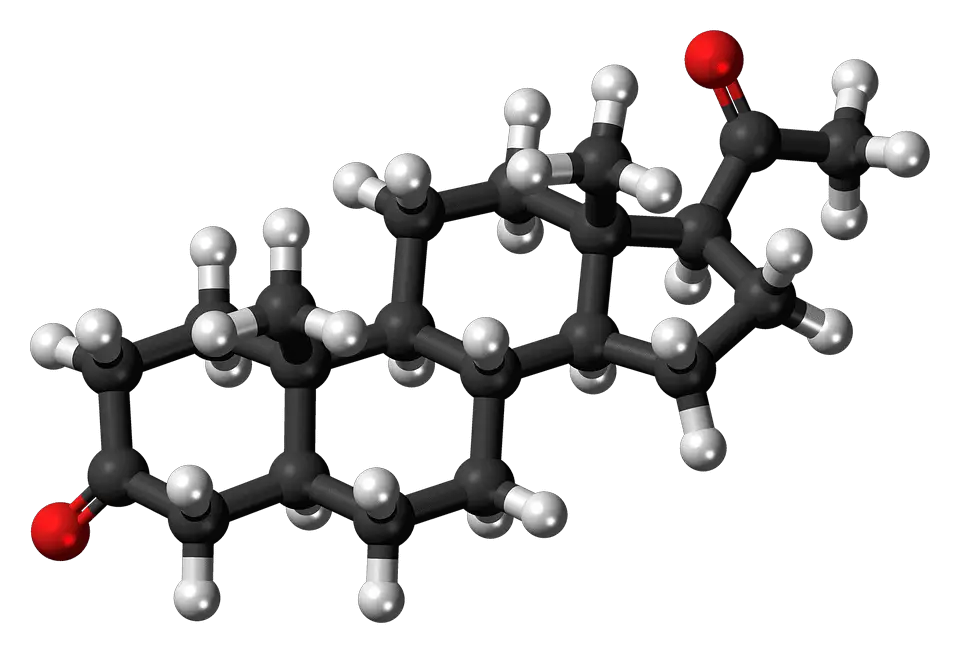
Not only does growth hormone facilitate muscle development, but studies have found that it also affects fat mobilisation. More specifically, growth hormone is associated with the breakdown of the triglycerides found in fatty tissue.
In other words, weight lifting releases growth hormone which may literally be turning your belly fat into muscle!
Cortisol Stores Fat! (No Thanks!)
Cortisol is the main stress hormone in both men and women.
Numerous studies have shown cortisol to be linked with fat gain. More specifically, cortisol release has been linked with fat storage around the abdominal and hip areas.

My point? Keep cortisol levels down!
Quality sleep and stress management are both factors known to decrease cortisol. And weight lifting has been shown to promote better sleep and relieve stress!
10 Tips For Lifting Weights To Burn Fat
So far, I have provided a comprehensive answer to the question “does weightlifting burn fat”.
To wrap things up, I will provide some pointers for you to begin your weightlifting journey to burn fat. These tips will help you create your own awesome fat-burning workout programme!
10 Ways To Lift Weights To Burn Fat
- Do full-body workouts to elevate your heart rate!
- Include big compound lifts to maximise fat loss and muscle gain in the shortest duration of time!
- Keep rest times to ~60 seconds to maintain an elevated heart rate and the muscle nutrient debt!
- Focus on intense workouts rather than long workouts!
- Use appropriate weight loads which allow for proper form!
- Overload frequently to keep challenging your muscles!
- Lift heavy weights with 8-12 reps for optimal fat burning!
- Lift to failure to stimulate muscle hypertrophy!
- Include supersets to elevate your heart rate!
- Optimise your weekly training volume for maximum training returns!
If you would like more detailed information on these tips, be sure to read my “Workout To Lose Fat And Gain Muscle Guide” which will expand on these 10 tips. There is also a simple barbell workout for you to try!
One Final Word On Cardio Vs Weights
Conclusion
There we have it!
In this post, I have provided a comprehensive answer to the common question:
“Does weight lifting burn fat?”
You now know that weightlifting is an extremely effective way to burn fat. And that combining weight lifting with cardio is the most effective road forward.
You have also learnt exactly how weight lifting burns fat, the kind of results you can expect from weight lifting, and how to lift weights to burn fat.
Tiago, Mindy, and Olivia all lost fat through weight training. And you can do it too!
Will you be adding weight training sessions to your weekly workout?
Feel free to send me a message if you have any questions! You can find my details on the “contact us” page.
You may also be interested in the downloadable Kalibre Blueprint PDF which details exactly how I gained 40lbs of lean muscle (it’s 100% free!). It details the exact exercises and nutrition (with printable worksheets) I used to go from skinny to ripped!
Thanks for reading guys!
Peace Out,
Kal
(Biochemistry BSc, Biomedical Sciences MSc, Ex-Skinny Guy)

